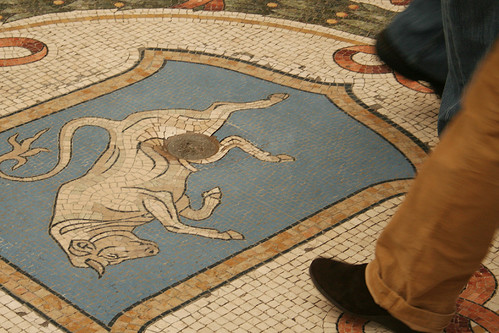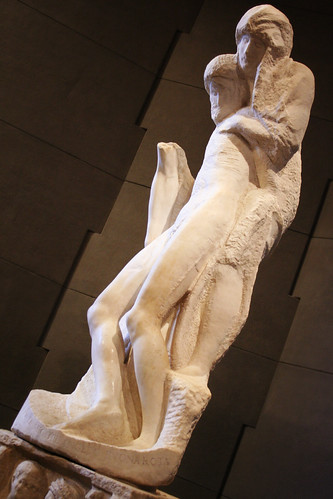Adjacent to Piazza del Duomo, the closest metro stop to the castle from my hotel, is a glass-domed area called the Galleria. It's full of expensive brand-named shops, restaurants and eateries (including the bar where Campari, the famous bright-red Italian bitter, was introduced), and artwork--paintings on the ceiling, and tile mosaics on the ground.

Celebrations of Italy's unification (or Risorgimento in the native tongue) can be seen all over Milan. The two most prominent mosaics in the Galleria are in honor of Italy's two historic capital cities since unification; an image of the wolf suckling Romulus and Remus for Rome, and an image of a bull for Turin (whose name in Italian, Torino, means "little bull"). Popular legend says that, for good luck, you plant your heel on the testicles of the bull and spin in place. There is always a crowd of people around the bull to watch the ritual and wait for their turn, and it is so popular that a hole several inches deep has been worn into the floor of the Galleria.

From the Duomo, Castello Sforzesco is a few minutes' walk down Via Dante, an all-pedestrian street lined with merchant stalls, cafes, and, of course, designer fashion and luxury shops. The castle contains a generous number of museums from pre-Roman art to Renaissance furniture, from Neolithic Italian archaeology to Egyptian mummies (yes, they have actual mummies). These are all housed in various portions of the castle, so as you walk among Gothic pillars and Crusades-era sarcophagi, you simultaneously witness the castle's twisting hallways and frescoed ceilings. One of my favorite rooms was the Sala delle Asse, in which the wall supports and ceilings had been painted with trees and interlacing branches by Leonardo da Vinci himself.
Castello Sforzesco houses Michelangelo's last sculpture, the incomplete Rondanini Pietà.


All in all, I saw three exhibits: ancient art (which included the Pietà as well as a variety of sculpture and glass from the 9th through 16th centuries), archaeology (Italian archaeological findings from the Neolithic period to the Iron Age), and Egypt (coffins, mummies, artifacts, and papyri from 3000 BCE to Ptolemaic Egypt).
Tomorrow, I will return to Florence.

No comments:
Post a Comment